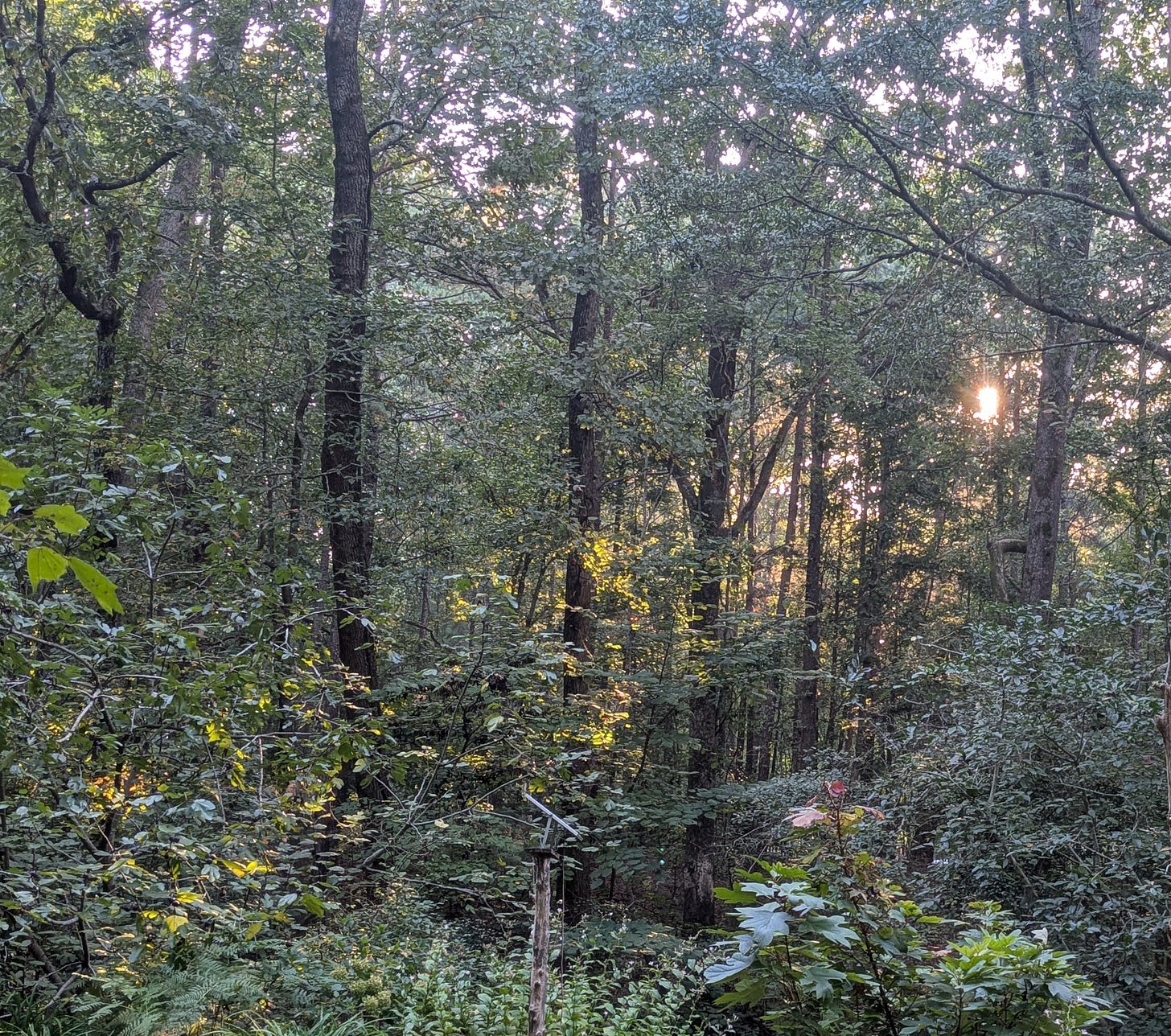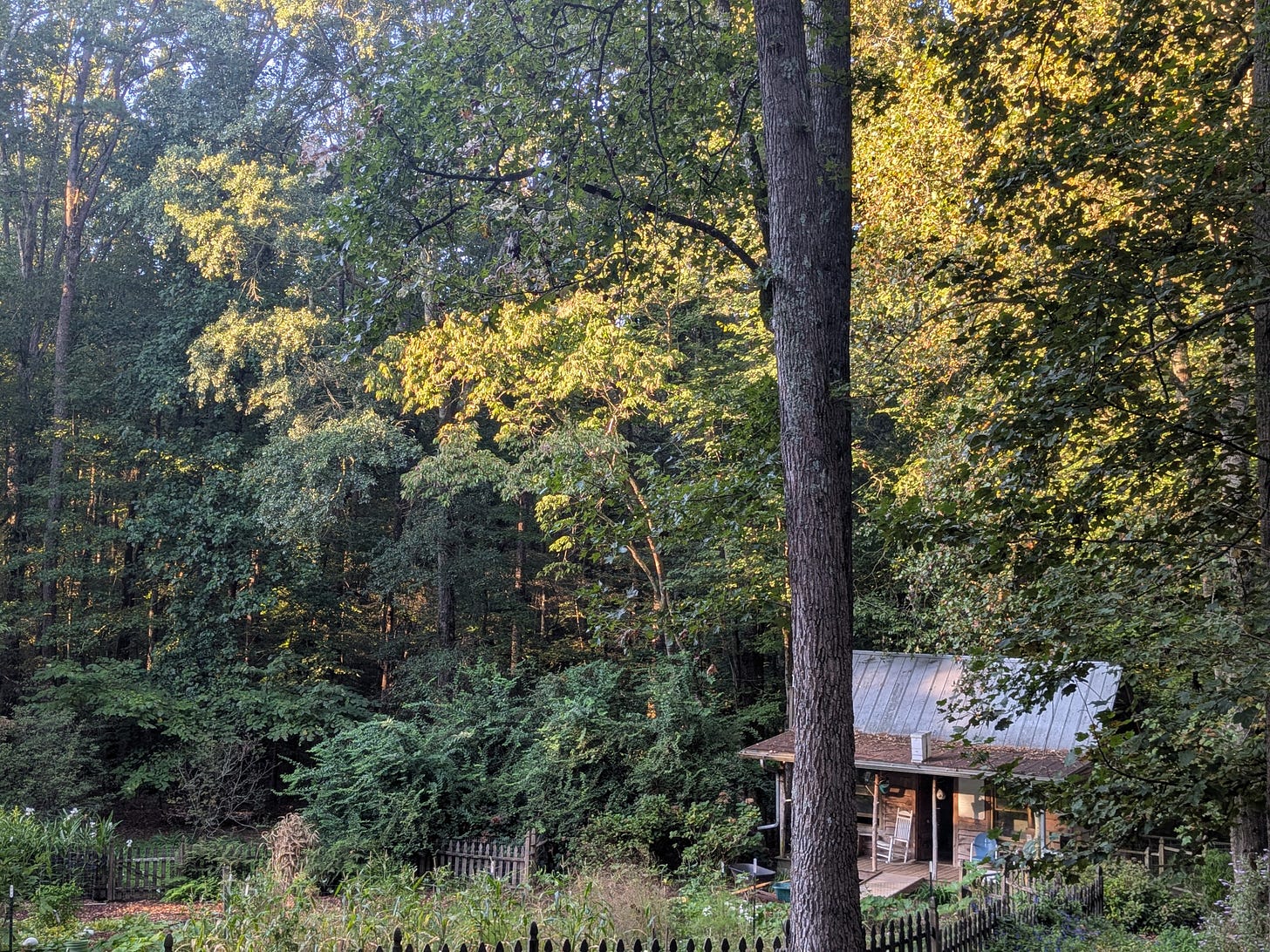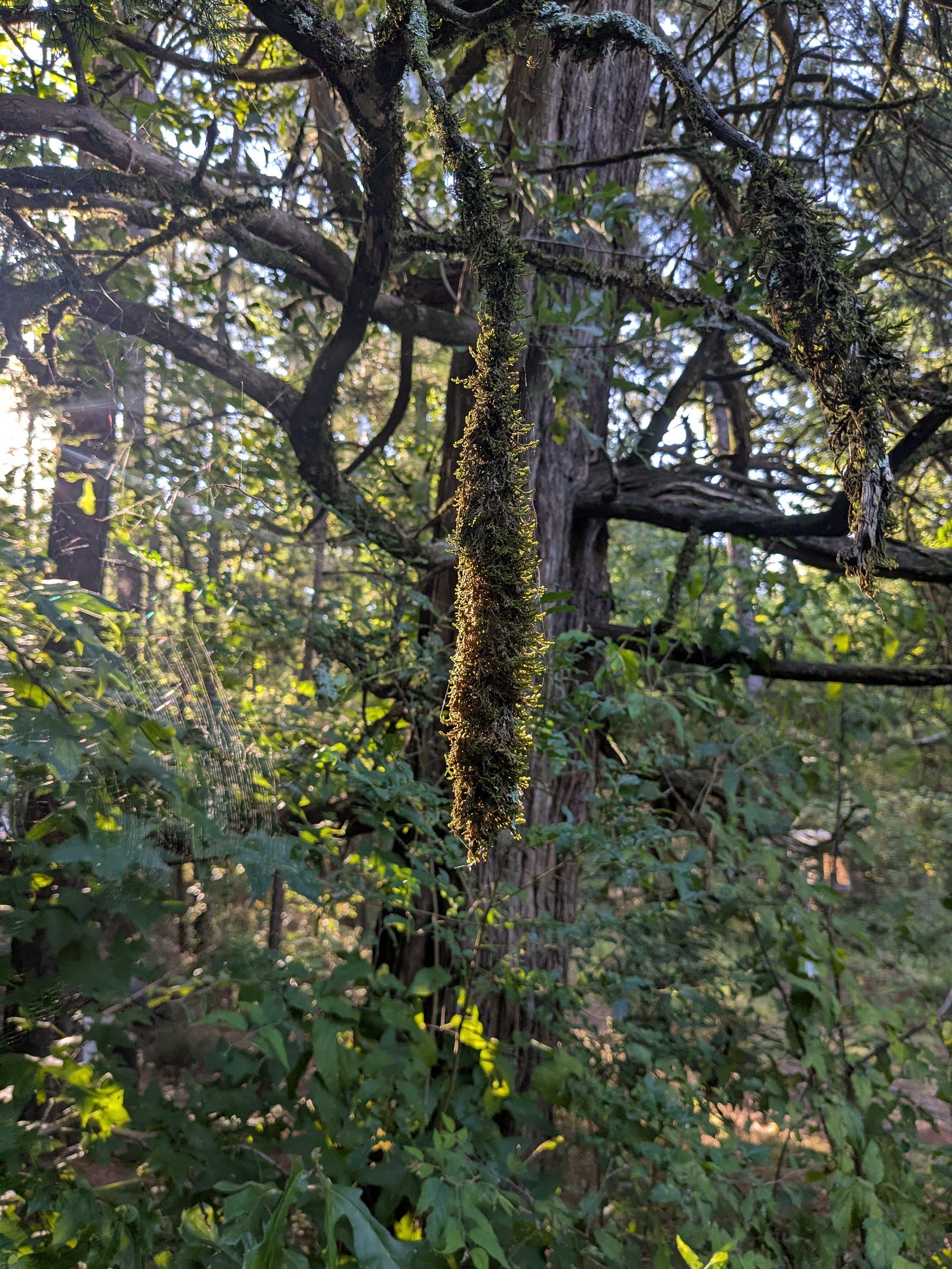Morning Light
A Meditation on Earth's Eye
Our neighbor’s roosters crow up the day just begun; they remind me of the epigraph of Thoreau’s Walden: “I do not propose to write an ode to dejection, but to brag as lustily as Chanticleer in the morning, standing on his roost, if only to wake my neighbors up.” The bravado of the line nods to Coleridge’s “Dejection: An Ode,” a poem that celebrates imagination drawn from the sublimity of the natural world. Like Thoreau, my morning, far from Coleridge’s sublimity, begins with barnyard beasts singing the light, and thus, Thoreau’s clarion call calls me. How might I sing this morning? How might I wake the neighbors up?
It is early and I am on the east-facing porch of our home, a little delta-shaped deck that looks over our kitchen garden. Light and shade play as the sun rises and shifts, a dance I imagine the trees love, willing partners to the sun’s lead. The dance is not a tango (it is far too gentle), nor is it a jig (too slow and subtle). It is less regular than a waltz but just as elegant. The time is not the ostinato of three beats or four; perhaps it is a dance outside of time, one with all time. The sun’s flares angle north toward me, grazing fig and fern, peeking through pines and oaks, simultaneously slipping through a gap to excite the Sourwood over the garden house. The coffee steams. Though I know it is the earth and I that actually turn, I fall very still to watch the ever-moving light.
An opening in the woods to the southeast allows the sun to light up the oaks beyond the tree line of our garden and meadow. At the edge of our forest, two tall oaks reach toward each other in a gothic arch, silhouetted by the light behind, no flying buttresses required. The bright green behind the arch crafts my cathedral’s rose window. Each day, the effect deepens until, as the leaves turn, a collage of reds and yellows glorifies God, the leaves’ final gift of the year. To the west of the arch, long shafts of light reach through the woods beneath the crowns, the most light the forest floor will receive until leaf fall.
The sun moves apace, the light perceptibly shifting through the woods, marked now by this branch or that leaf; it grazes the edges of poplar leaves, finds a larger gap in the trees, and at quarter past an oak, it looks into my eyes, such that, Moses-like, I must turn away lest I die. Within a breath, I find myself in the shadow of another oak as God passes by. A grand beauty berry catches the light, and the hint of a breeze highlights the subtle moves of dewed spider threads now prismed as they cast an ephemeral rainbow. Somewhere behind the ambient murmur of crickets and the call of crows, the silks are singing:
I have never heard a spider symphony
Though I wonder if the silks sing
When plucked by so many legs
Octopizzicato
Bits of sun, finding its way through the densely leaved forest edge, twinkle like stars from the vagaries of breeze, and I marvel that such a mighty force, the founder of so much life, could be so light and humble. It seems an incarnation of a sort, the great sun aslant across the atmosphere captured and cradled in the most terrestrial forms, a dance offered each morning for those with eyes to see, a prelude to the worship of the day.
My coffee complete, I move through my morning paths to greet the green of the garden, to check for new fruit set in the night, and for the next ripe cantaloupe. Elvis the garden cat mewls a low morning greeting. The dance of light and shade follows me, encircles me. The sun, now caught by thick pine tops, now silhouetting the great oak in the bee meadow, cycles up, ever up. I see it now mirrored in a window of the garden house, reflected on my hands, shadows on a page of light. What cuneiform must I decipher to read this ephemeral message? The hens squawk, they too quite literally up with the sun. As I walk toward their run, the sun catches the great leaves of the Tromboncino squash now leaning in toward it, or rather, the squash leaves, like green catchers’ mitts, gather the sun. They glow in this first light of the day; the happy chlorophyll alight begins to perform its daily magic.
A tattered old black swallowtail butterfly flits overhead, flying west toward a double-trunked poplar, bespeckled with yellowing leaves, now in full sun. On the eastern end of the garden, near the honey bee hives, the dew-soaked blackberry canes in mottled light glisten silver. The early light filtering through the pines finds the bees still huddled in the hives. They remain humming together, gathered to maintain heat for the baby bees; soon they too will greet the founder of their daily feast, their source and guide, part of the very language of their winged life. The bees remarkable eyes see a different spectrum than ours, as well as polarized light: the former for spotting the favored sources of food, the latter giving them the ability to know the exact angle of the sun even when it is obscured by clouds, which they use to tell each other where pollen and nectar can be found. Their life is continuous with the sun, perhaps no more than mine, though they seem more attuned to it, more one with it.
Turning west, I see the moon over the crowns of poplar and beech, a third-quarter waning gibbous, as it continues its cycle. Sun and moon, light and shadow, reflection and polarization, all moving, shifting, dancing. Some moss on an ancient cedar finds its morning fix of light. The scaly bark of white oaks now find the spotlight, the smooth bark of beeches too. Even our senior Pyrenees, ready for breakfast, lolls in the sun. I squat with him and feel the warmth of his back, bright white in the sun.
The cats and chickens fed, I walk back through the vegetable garden. The leaves, half-alight, tilt east. I angle my head like the squash leaves to take in as much of the sun as I can. The exuberant chlorophyll all around me glows, and though much of the garden shows its September age, another day closer to the autumnal equinox, we all celebrate the youth of this day and are renewed. I greet all my dear green ones that I have known since germination and together we thank God for the sun. As I turn to leave the garden, I pass the first seedlings of the fall garden, the carrots and beets, the arugula and endive, the parsnips, and I remember that like light and shade, the life of the garden is ever-changing and shifting, is ever-ending and yet beginning. The garden, the day, the year, all part of the dance of light and life.
The Community of a Fig Tree
On that day, says the Lord of hosts, you shall invite each other to come under your vine and fig tree.”
-- Zechariah 3:9-10
On a hot summer day in August of 2020, the figs on our farm, in riotous abundance, called me and many of the more than human world to enjoy the bounty. Sitting under the shade offered by the luscious leaves, I fell into a reverie at least in part inspired by the heat, the fermenting figs, and the buzz of 10,000 honey bees. My reflection on this reverie became the first chapter of A Book of Season (https://www.abookofseasons.com/), which will be published by Mercer University Press in May of 2026. Watch this Substack for information on how to order.








Ron, if you wrote about shag carpeting I’d read it for no doubt it would be a glorious description! Your words and sentences are as intoxicating as the subject on which you’re writing! Looking forward to more.